Colin Penny Skipper of “Flamer 4” has a well-deserved reputation for putting anglers amongst quality fish over a period of close to 20 years.
Weymouth is Colin’s base where he sets out on a regular basis to target the prolific waters off Dorset’s Jurassic coast. Several years ago Colin visited South Devon’s historic maritime town of Dartmouth and became enchanted by the place.
As a result each year Colin endeavours to organise a trip that has affectionately been named the annual Westcountry Trip. Fishing the coastal waters off both Devon and Dorset. The anglers who join Colin for this charter trip tend to be regulars who relish the comradeship and banter that such trips generate. The trip is typically a five-day session including a bit of wrecking on route to Dartmouth a journey of around 55miles, mixed fishing off the South Devon Coast with another wrecking session on the way back.
I had been invited to join Colin along with Ammo baits boss Ian Tyldesley at Dartmouth on the second day of this year’s five-day venture. My wife Pauline had travelled down to Dartmouth with me on the previous day and was content to browse the lively streets with their trendy boutiques, upmarket gift shops and coffee houses. There are plenty of places to stay in Dartmouth and eating places to suit every taste.
[caption id="attachment_14744" align="aligncenter" width="1000"]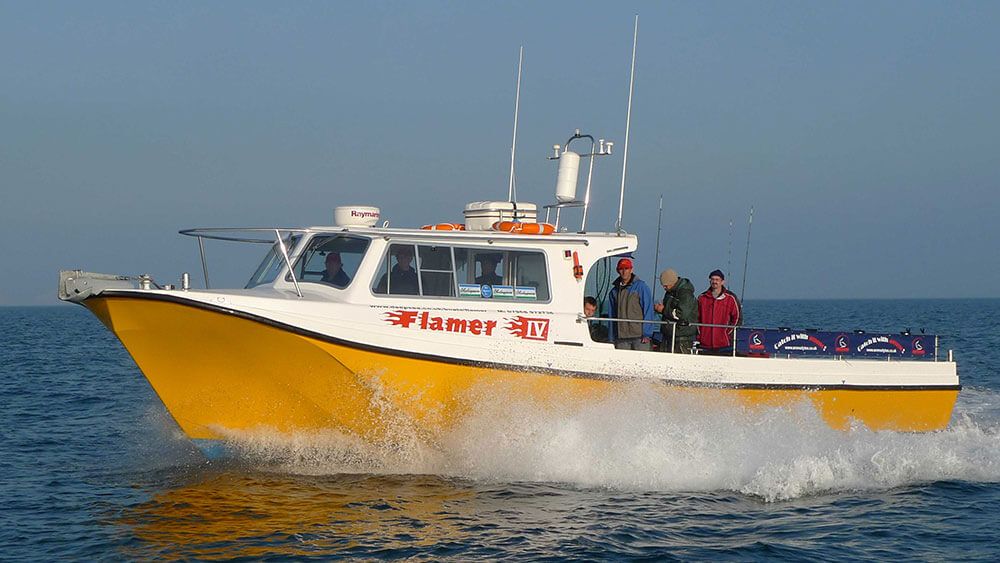 Flamer IV[/caption]
Flamer IV[/caption]
I joined Flamer at just after 8.00am on the main ferry pontoon and was relieved to find I was not the last to arrive. In addition to Ian Tyldesley of Ammo baits the party consisted of eight regulars on Colin’s boat. Several of them familiar faces from my previous trips on-board Flamer 4. Dave King, Steve Lysaght, Trevor Pegg, Peter Gillet (Shrek) Stephan Attwood, Dodgy Dave Barton, David Jenkins and Bob Monk made up the enthusiastic bunch that were immediately threading line through their rod rings and selecting rigs for the day ahead.
There is always a great sense of anticipation as the boat sets forth on the way to another days fishing adventure. Cruising slowly down the Dart estuary it was time to savour the sights. Behind us upon the hill above Dartmouth was the historic Britannia Naval College famous for its Royal Connections. On our right was Bayards Cove where the Mayflower set sail for America carrying the Pilgrim Fathers in 1620. The location is also familiar to those of a certain age as the setting for filming of the popular 1970’s TV drama “The Onedin Line”. Some impressive houses that would undoubtedly grace the pages of upmarket country magazines punctuate the steep wooded slopes of the estuary. The entrance to the estuary is guarded by Dartmouth castle a popular tourist destination.
Free from the speed restrictions of the harbour Colin opened up the throttle and headed for the first mark of the day. Bull huss were to be our target; a species that dwells in rocky gullies full of waving kelp all along the beautiful South Hams coastline. Ian had brought a box of fresh mackerel packed with ice that had been landed at St Ives the previous day. These are perfect baits for bull huss a species that is particularly partial to fish baits such as mackerel or squid.
Nothing sophisticated required here. I elected to use a Sakuma 6/0 Manta hook tied to a 2ft trace of 80lb mono. This would be anchored to the seabed with a 12oz lead connected using a simple Clements boom. My main line was 60lb Berkley Whiplash Braid.
As we steamed towards Start Point at the Western End of Start Bay I chatted with Colin and the anglers on board. Friendly banter ensued with tales of past trips and angling adventures. Boat fishing is very much a social occasion and despite a competitive edge it is to me very much a team effort. Colin ran a species points based competition throughout the five day campaign but I am sure all on board tend to round the catches up at the end of the trip recalling the collective haul as opposed to their individual success.
When Colin was happy that we were on the mark he dropped the anchor; allowing the boat to settle before emitting his familiar cry; “Get em down”.
It was not long before a fish found Ian Tyldesley’s flank of fresh mackerel and a well-bent rod indicated that he had hooked a decent fish that was using the strong tide to its advantage. We peered into the clear waters as the leopard like flanks of a writhing huss materialised. Colin scooped the fish into the net and swung it over the gunnels. A smiling Ian then attempted to get the huss to pose with him for a quick picture before being released.
A sharp rasping bite alerted me to another huss tugging at my own bait. Minutes later a small huss was on board and admired briefly before being dropped overboard. David King was next into action landing a huss that would undoubtedly have pulled the scales beyond double figures.
[caption id="attachment_14743" align="aligncenter" width="1000"]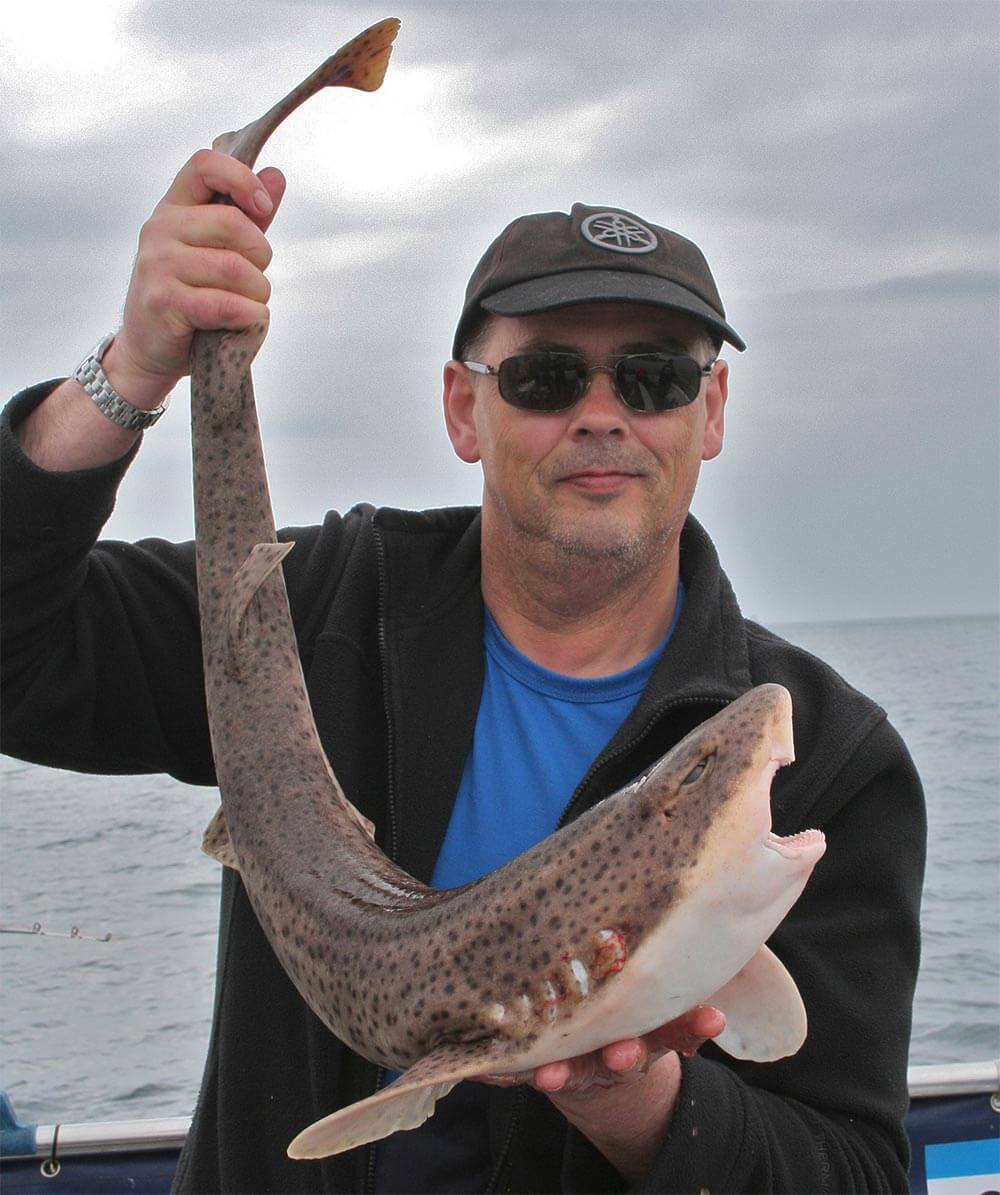 Dave King with the best huss of the day[/caption]
Dave King with the best huss of the day[/caption]
As the tide eased Colin decided it was time to up anchor and head for the Skerries Banks in search of the brightly spotted plaice for which they are famed.
Terminal rigs for plaice are often brightly decorated affairs with anglers adorning traces with colourful beads and attractors. We had an array of baits to put on the menu today, frozen black Ammo lug, king ragworm and Tesco’s finest king prawns each of these baits were tipped off with a tantalising sliver of squid. Sizes 1 to 1/0 hooks are about right for plaice that do not have massive mouths.
[caption id="attachment_14740" align="aligncenter" width="1000"]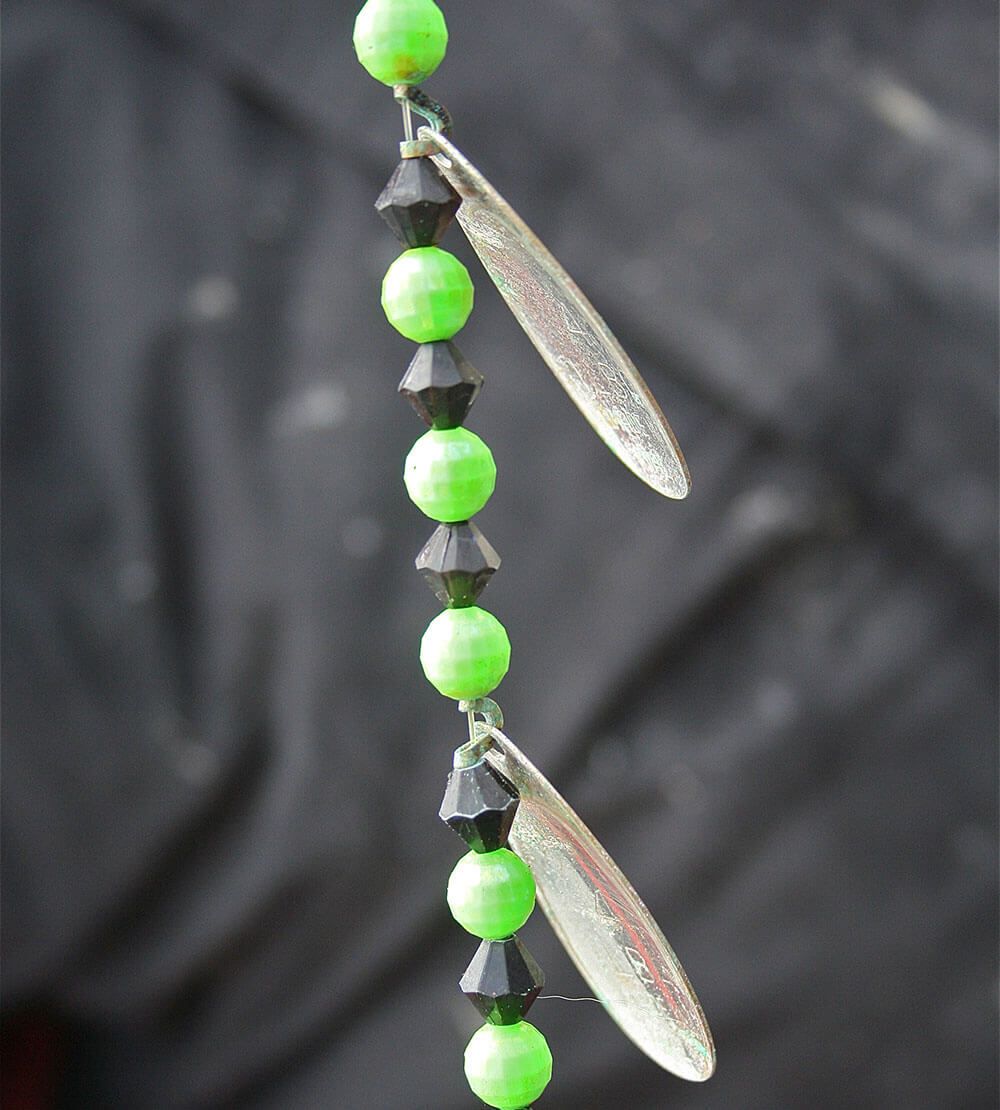 Attractive beads and blades.[/caption]
Attractive beads and blades.[/caption]
Colin took Flamer to the up-tide end of the bank using his experience to line up a productive drift. Wind and tide will impact upon how the boat progresses and consequently on how the baits are presented to the waiting flatfish. The baits are lowered to the bottom and the rods held at all times. Using braided line it is possible to feel every ridge of sand as the weight trundles along the seabed sending up little puffs of sand as it bounces the bottom hopefully attracting the inquisitive plaice. The angler needs to feel very carefully for when a bite comes it is then essential to pay out several yards of slack line. No frantic striking just let the plaice devour the bait. When you judge that the plaice has had time, engage the reel watch the rod tip curve over and tighten. The plaice will start to kick on the end of the line. Let the rod absorb the lunges and slowly persuade the flatfish towards the surface enjoying the life that reverberates up through the line to be absorbed by the light rod.
As we neared the end of our first drift it was Trevor Pegg who was first to connect bringing a pleasing fish topping two pounds to the waiting net. Each drift brings a plaice or two to the days tally with all baits seeming to work well.
[caption id="attachment_14747" align="aligncenter" width="1000"]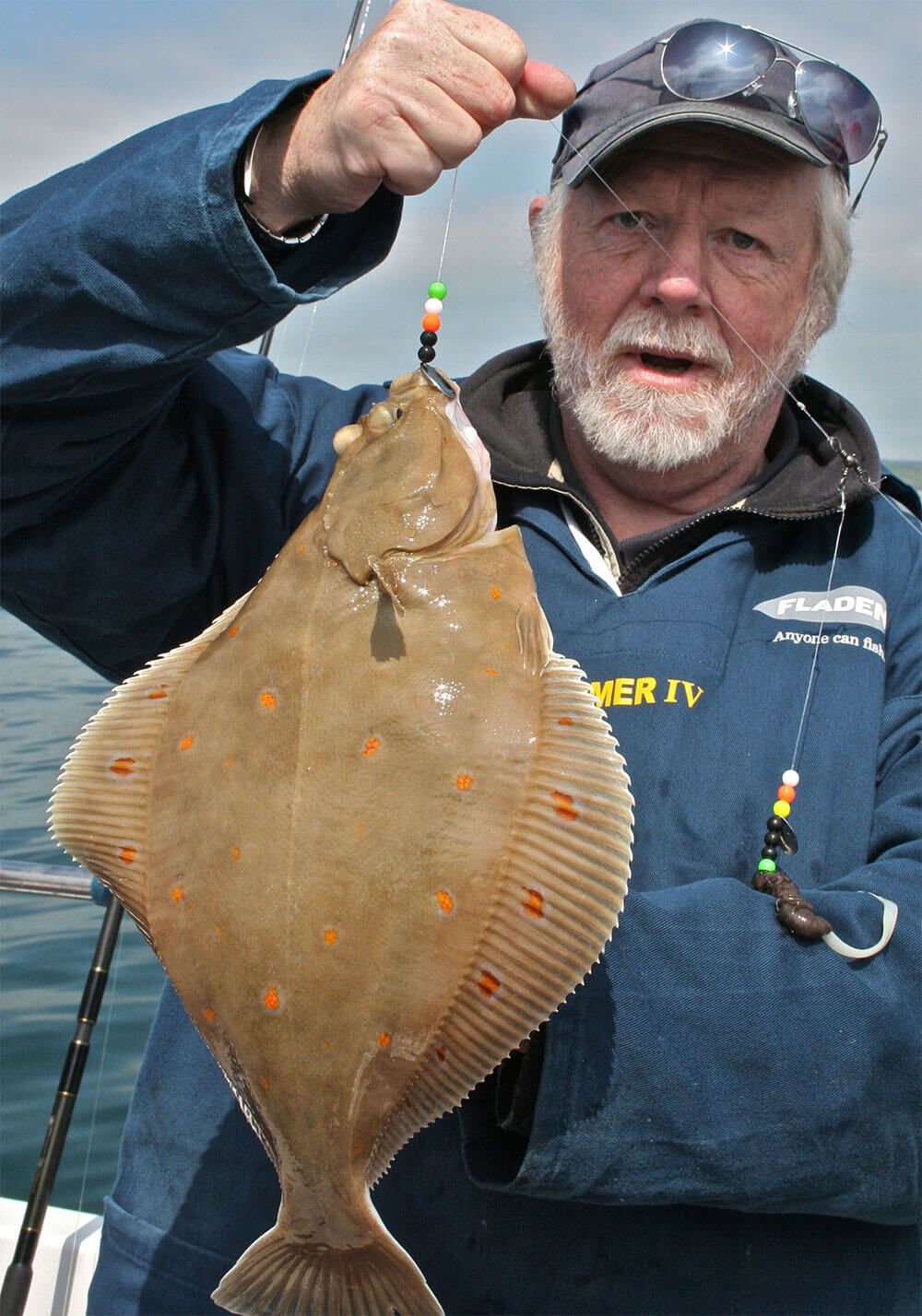 A pleasing plaice for Trevor Pegg[/caption]
A pleasing plaice for Trevor Pegg[/caption]
Careful manoeuvring of tackle and consideration of weight selection keeps tangles to a minimum. I alternated between a 4oz lead and an 8oz lead. Colin sets up each drift to give one drift with the starboard lines going under the boat then a drift with the lines going away from the boat. When the baits and lines are going away from the boat a light lead keeps the tackle clear of the up-tide lines. The anglers whose lines are going under the boat should use a heavier lead ensuring their lines are clear of those on the other side of the boat.
[caption id="attachment_14742" align="aligncenter" width="1000"]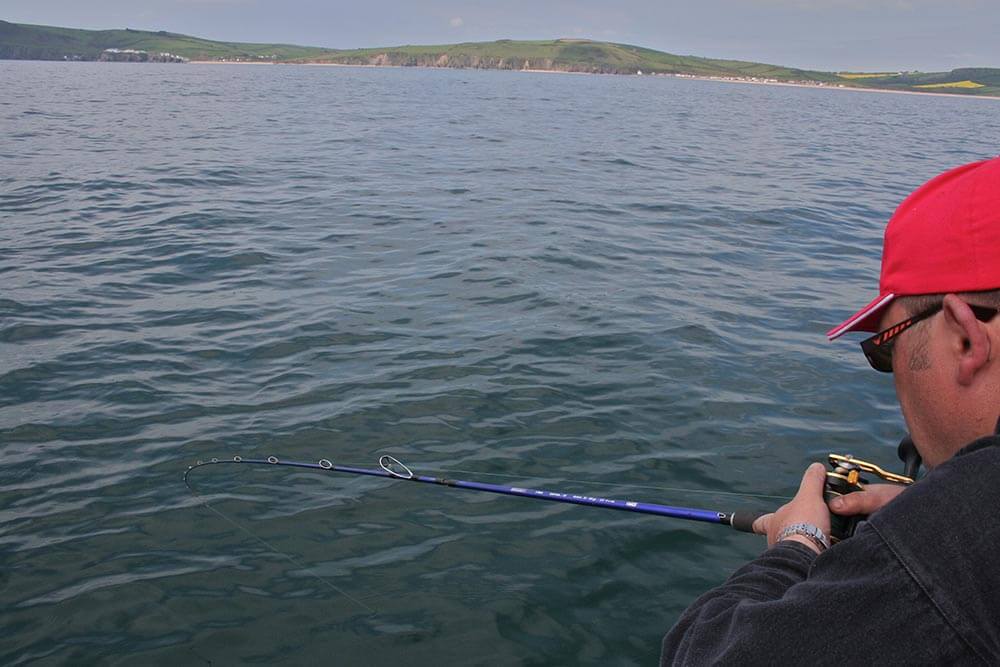 Concentration for Stephan Attwood in anticipation of a plaice bite[/caption]
Concentration for Stephan Attwood in anticipation of a plaice bite[/caption]
Colin supplies a steady supply of tea, coffee and soup to keep dehydration at bay.
As the tide eases so does the plaice’s appetite and anticipating this Colin suggests a move to a deep-water mark where whiting were the target species. With close to 180ft beneath the boat a heavy lead was required to take the baits down. A simple two-hook paternoster with 1/0 hooks baited with mackerel strips was my selected rig. This was sent down until I felt the pleasing thud as the weight touched down in a dark and mysterious place far beneath the surface. I soon felt a vigorous rattle on the rod tip and raised the rod gently in response to determine if I had succeeded in hooking a fish. The tap tap transmitted through the rod told me that my hooks were engaged. I pumped the fish to the surface and swung a brace aboard that most quintessential sea fish; the whiting. These predatory fish with their big eyes and sharp teeth are one of our most obliging fish.
[caption id="attachment_14746" align="aligncenter" width="1000"]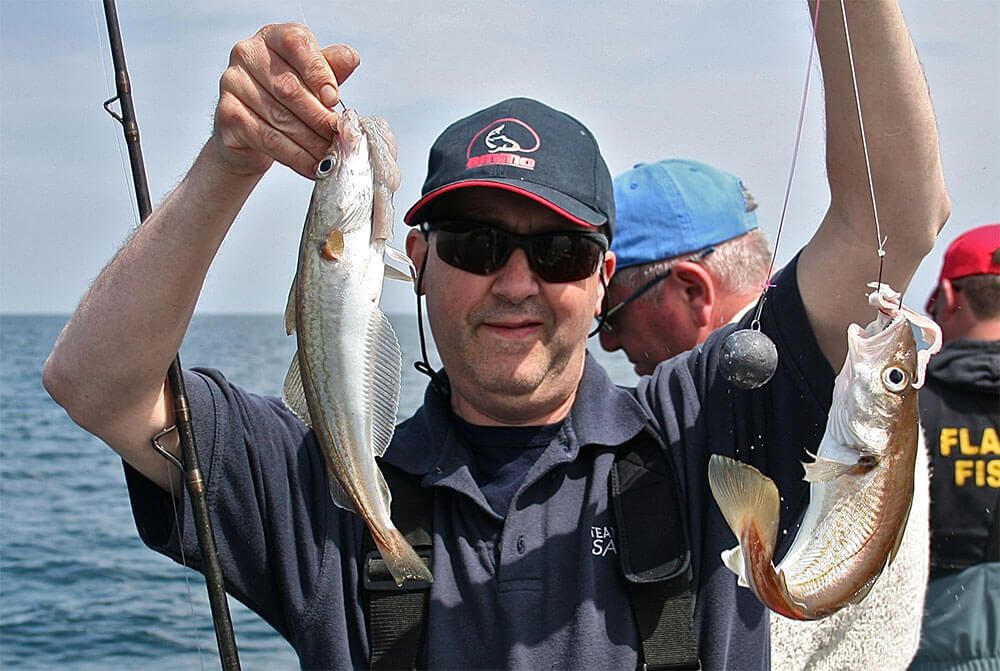 Whiting for Wayne Thomas[/caption]
Whiting for Wayne Thomas[/caption]
Following this short interlude for whiting we return to the Skerries and their plaice for the remainder of the day. Again we drift upon a calm sea as the sun beats down from a blue sky interspersed with high white stratocumulus cloud. There is the thrilling sight of the occasional gannet descending upon the water with its stunning high-speed dive. All of this is absorbed as the baits trundle along searching the seabed. The day’s tally grows slowly but surely with each drift. The plaice had so far failed to locate Ian Tyldesly tempting baits but success came at last as departure time approached. A pleasing fish of close to 2lb is held up for the camera. Ian fails to hear Colin state that its time to reel in and lowers a fresh trace baited with Ammo black lug to the bottom. Within a minute he has his second plaice of the day and holds it aloft with Steve Lysaght who has also caught a last cast fish.
[caption id="attachment_14745" align="aligncenter" width="1000"]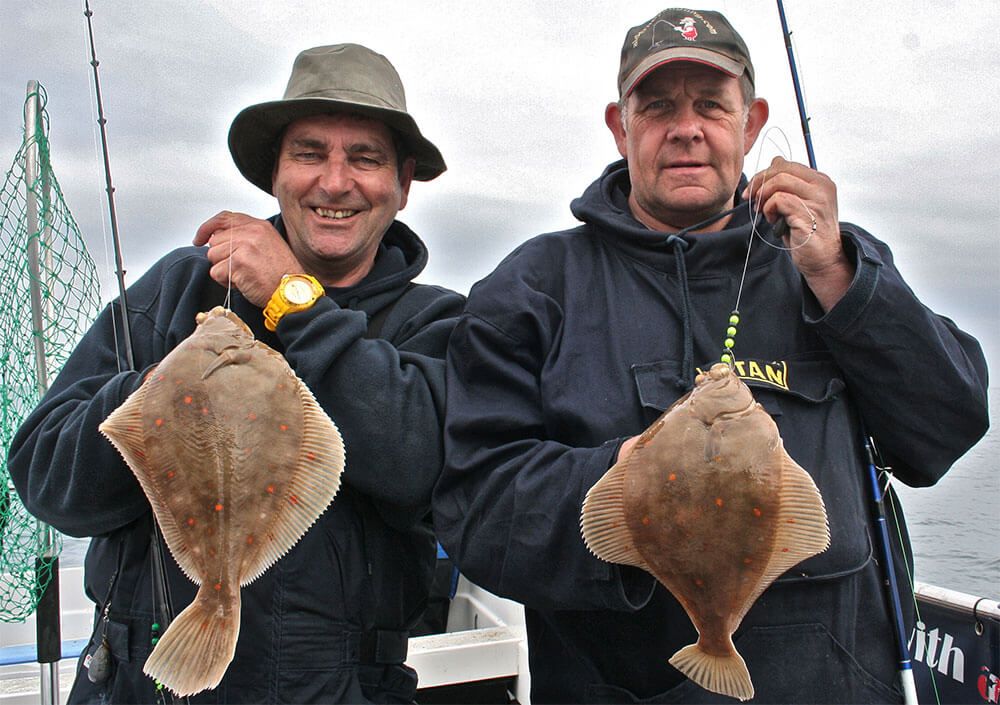 Last plaice goes to Ian Tyldesley and Steve Lysaght[/caption]
Last plaice goes to Ian Tyldesley and Steve Lysaght[/caption]
As always the day has drifted past all too fast and we are heading back to Dartmouth. The tally at the end of the day stands at 32 plaice, three bull huss, six whiting and the inevitable solitary dogfish.
On the steam back the decks are scrubbed clean and tackle tidied. Again it’s a delight to sail into Dartmouth Harbour as ferryboats chug to and fro, yacht’s their crews busy as ice cream lickers observe from the busy waterside embankment. The haunting hoot of the steam train drifts through the air adding a timeless feel to the day that is furthered by the site of the “Kingswear Castle” a refurbished paddle steamer that plies its trade-taking tourists on estuary trips.
Sadly the impending weather forecast was not good for the remainder of the “Westcountry Trip” and Colin was forced to make for Weymouth early next day. Strong North Westerly winds would not be viable for returning to Weymouth. On the return Journey they stopped over a couple of wrecks landing cod, Pollock and ling.
[caption id="attachment_14739" align="aligncenter" width="1000"]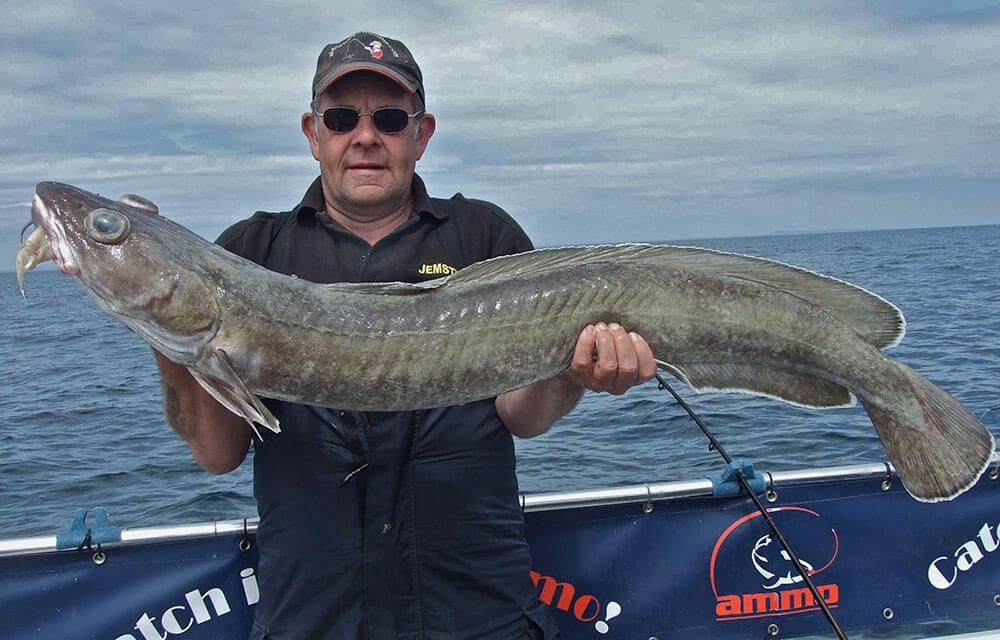 Steve with a 19lb 13oz Ling[/caption]
Steve with a 19lb 13oz Ling[/caption]
The 2013 season has been badly hit by strong cold winds taking many days out of the Charter skipper’s diary. Tackle shops and the industry as a whole has undoubtedly suffered from a combination of weather and the economic downturn. All the more reason to make the best of those Flaming good days we yearn for.
BOAT: FLAMER CHARTERS
Skipper: Colin Penny – 01305 766961
Mobile: 07968 – 972736
Email : colinpennyfu2@aol.com
www.deepsea.co.uk/boats/flamer
ACCOMODATION
My wife Pauline and I stayed at: The Ship In Dock Inn
Telephone 01803 839614 - Ideally situated close to the Waterfront
Weymouth is Colin’s base where he sets out on a regular basis to target the prolific waters off Dorset’s Jurassic coast. Several years ago Colin visited South Devon’s historic maritime town of Dartmouth and became enchanted by the place.
As a result each year Colin endeavours to organise a trip that has affectionately been named the annual Westcountry Trip. Fishing the coastal waters off both Devon and Dorset. The anglers who join Colin for this charter trip tend to be regulars who relish the comradeship and banter that such trips generate. The trip is typically a five-day session including a bit of wrecking on route to Dartmouth a journey of around 55miles, mixed fishing off the South Devon Coast with another wrecking session on the way back.
I had been invited to join Colin along with Ammo baits boss Ian Tyldesley at Dartmouth on the second day of this year’s five-day venture. My wife Pauline had travelled down to Dartmouth with me on the previous day and was content to browse the lively streets with their trendy boutiques, upmarket gift shops and coffee houses. There are plenty of places to stay in Dartmouth and eating places to suit every taste.
[caption id="attachment_14744" align="aligncenter" width="1000"]
 Flamer IV[/caption]
Flamer IV[/caption]I joined Flamer at just after 8.00am on the main ferry pontoon and was relieved to find I was not the last to arrive. In addition to Ian Tyldesley of Ammo baits the party consisted of eight regulars on Colin’s boat. Several of them familiar faces from my previous trips on-board Flamer 4. Dave King, Steve Lysaght, Trevor Pegg, Peter Gillet (Shrek) Stephan Attwood, Dodgy Dave Barton, David Jenkins and Bob Monk made up the enthusiastic bunch that were immediately threading line through their rod rings and selecting rigs for the day ahead.
There is always a great sense of anticipation as the boat sets forth on the way to another days fishing adventure. Cruising slowly down the Dart estuary it was time to savour the sights. Behind us upon the hill above Dartmouth was the historic Britannia Naval College famous for its Royal Connections. On our right was Bayards Cove where the Mayflower set sail for America carrying the Pilgrim Fathers in 1620. The location is also familiar to those of a certain age as the setting for filming of the popular 1970’s TV drama “The Onedin Line”. Some impressive houses that would undoubtedly grace the pages of upmarket country magazines punctuate the steep wooded slopes of the estuary. The entrance to the estuary is guarded by Dartmouth castle a popular tourist destination.
Free from the speed restrictions of the harbour Colin opened up the throttle and headed for the first mark of the day. Bull huss were to be our target; a species that dwells in rocky gullies full of waving kelp all along the beautiful South Hams coastline. Ian had brought a box of fresh mackerel packed with ice that had been landed at St Ives the previous day. These are perfect baits for bull huss a species that is particularly partial to fish baits such as mackerel or squid.
Nothing sophisticated required here. I elected to use a Sakuma 6/0 Manta hook tied to a 2ft trace of 80lb mono. This would be anchored to the seabed with a 12oz lead connected using a simple Clements boom. My main line was 60lb Berkley Whiplash Braid.
As we steamed towards Start Point at the Western End of Start Bay I chatted with Colin and the anglers on board. Friendly banter ensued with tales of past trips and angling adventures. Boat fishing is very much a social occasion and despite a competitive edge it is to me very much a team effort. Colin ran a species points based competition throughout the five day campaign but I am sure all on board tend to round the catches up at the end of the trip recalling the collective haul as opposed to their individual success.
When Colin was happy that we were on the mark he dropped the anchor; allowing the boat to settle before emitting his familiar cry; “Get em down”.
It was not long before a fish found Ian Tyldesley’s flank of fresh mackerel and a well-bent rod indicated that he had hooked a decent fish that was using the strong tide to its advantage. We peered into the clear waters as the leopard like flanks of a writhing huss materialised. Colin scooped the fish into the net and swung it over the gunnels. A smiling Ian then attempted to get the huss to pose with him for a quick picture before being released.
A sharp rasping bite alerted me to another huss tugging at my own bait. Minutes later a small huss was on board and admired briefly before being dropped overboard. David King was next into action landing a huss that would undoubtedly have pulled the scales beyond double figures.
[caption id="attachment_14743" align="aligncenter" width="1000"]
 Dave King with the best huss of the day[/caption]
Dave King with the best huss of the day[/caption]As the tide eased Colin decided it was time to up anchor and head for the Skerries Banks in search of the brightly spotted plaice for which they are famed.
Terminal rigs for plaice are often brightly decorated affairs with anglers adorning traces with colourful beads and attractors. We had an array of baits to put on the menu today, frozen black Ammo lug, king ragworm and Tesco’s finest king prawns each of these baits were tipped off with a tantalising sliver of squid. Sizes 1 to 1/0 hooks are about right for plaice that do not have massive mouths.
[caption id="attachment_14740" align="aligncenter" width="1000"]
 Attractive beads and blades.[/caption]
Attractive beads and blades.[/caption]Colin took Flamer to the up-tide end of the bank using his experience to line up a productive drift. Wind and tide will impact upon how the boat progresses and consequently on how the baits are presented to the waiting flatfish. The baits are lowered to the bottom and the rods held at all times. Using braided line it is possible to feel every ridge of sand as the weight trundles along the seabed sending up little puffs of sand as it bounces the bottom hopefully attracting the inquisitive plaice. The angler needs to feel very carefully for when a bite comes it is then essential to pay out several yards of slack line. No frantic striking just let the plaice devour the bait. When you judge that the plaice has had time, engage the reel watch the rod tip curve over and tighten. The plaice will start to kick on the end of the line. Let the rod absorb the lunges and slowly persuade the flatfish towards the surface enjoying the life that reverberates up through the line to be absorbed by the light rod.
As we neared the end of our first drift it was Trevor Pegg who was first to connect bringing a pleasing fish topping two pounds to the waiting net. Each drift brings a plaice or two to the days tally with all baits seeming to work well.
[caption id="attachment_14747" align="aligncenter" width="1000"]
 A pleasing plaice for Trevor Pegg[/caption]
A pleasing plaice for Trevor Pegg[/caption]Careful manoeuvring of tackle and consideration of weight selection keeps tangles to a minimum. I alternated between a 4oz lead and an 8oz lead. Colin sets up each drift to give one drift with the starboard lines going under the boat then a drift with the lines going away from the boat. When the baits and lines are going away from the boat a light lead keeps the tackle clear of the up-tide lines. The anglers whose lines are going under the boat should use a heavier lead ensuring their lines are clear of those on the other side of the boat.
[caption id="attachment_14742" align="aligncenter" width="1000"]
 Concentration for Stephan Attwood in anticipation of a plaice bite[/caption]
Concentration for Stephan Attwood in anticipation of a plaice bite[/caption]Colin supplies a steady supply of tea, coffee and soup to keep dehydration at bay.
As the tide eases so does the plaice’s appetite and anticipating this Colin suggests a move to a deep-water mark where whiting were the target species. With close to 180ft beneath the boat a heavy lead was required to take the baits down. A simple two-hook paternoster with 1/0 hooks baited with mackerel strips was my selected rig. This was sent down until I felt the pleasing thud as the weight touched down in a dark and mysterious place far beneath the surface. I soon felt a vigorous rattle on the rod tip and raised the rod gently in response to determine if I had succeeded in hooking a fish. The tap tap transmitted through the rod told me that my hooks were engaged. I pumped the fish to the surface and swung a brace aboard that most quintessential sea fish; the whiting. These predatory fish with their big eyes and sharp teeth are one of our most obliging fish.
[caption id="attachment_14746" align="aligncenter" width="1000"]
 Whiting for Wayne Thomas[/caption]
Whiting for Wayne Thomas[/caption]Following this short interlude for whiting we return to the Skerries and their plaice for the remainder of the day. Again we drift upon a calm sea as the sun beats down from a blue sky interspersed with high white stratocumulus cloud. There is the thrilling sight of the occasional gannet descending upon the water with its stunning high-speed dive. All of this is absorbed as the baits trundle along searching the seabed. The day’s tally grows slowly but surely with each drift. The plaice had so far failed to locate Ian Tyldesly tempting baits but success came at last as departure time approached. A pleasing fish of close to 2lb is held up for the camera. Ian fails to hear Colin state that its time to reel in and lowers a fresh trace baited with Ammo black lug to the bottom. Within a minute he has his second plaice of the day and holds it aloft with Steve Lysaght who has also caught a last cast fish.
[caption id="attachment_14745" align="aligncenter" width="1000"]
 Last plaice goes to Ian Tyldesley and Steve Lysaght[/caption]
Last plaice goes to Ian Tyldesley and Steve Lysaght[/caption]As always the day has drifted past all too fast and we are heading back to Dartmouth. The tally at the end of the day stands at 32 plaice, three bull huss, six whiting and the inevitable solitary dogfish.
On the steam back the decks are scrubbed clean and tackle tidied. Again it’s a delight to sail into Dartmouth Harbour as ferryboats chug to and fro, yacht’s their crews busy as ice cream lickers observe from the busy waterside embankment. The haunting hoot of the steam train drifts through the air adding a timeless feel to the day that is furthered by the site of the “Kingswear Castle” a refurbished paddle steamer that plies its trade-taking tourists on estuary trips.
Sadly the impending weather forecast was not good for the remainder of the “Westcountry Trip” and Colin was forced to make for Weymouth early next day. Strong North Westerly winds would not be viable for returning to Weymouth. On the return Journey they stopped over a couple of wrecks landing cod, Pollock and ling.
[caption id="attachment_14739" align="aligncenter" width="1000"]
 Steve with a 19lb 13oz Ling[/caption]
Steve with a 19lb 13oz Ling[/caption]The 2013 season has been badly hit by strong cold winds taking many days out of the Charter skipper’s diary. Tackle shops and the industry as a whole has undoubtedly suffered from a combination of weather and the economic downturn. All the more reason to make the best of those Flaming good days we yearn for.
BOAT: FLAMER CHARTERS
Skipper: Colin Penny – 01305 766961
Mobile: 07968 – 972736
Email : colinpennyfu2@aol.com
www.deepsea.co.uk/boats/flamer
ACCOMODATION
My wife Pauline and I stayed at: The Ship In Dock Inn
Telephone 01803 839614 - Ideally situated close to the Waterfront

